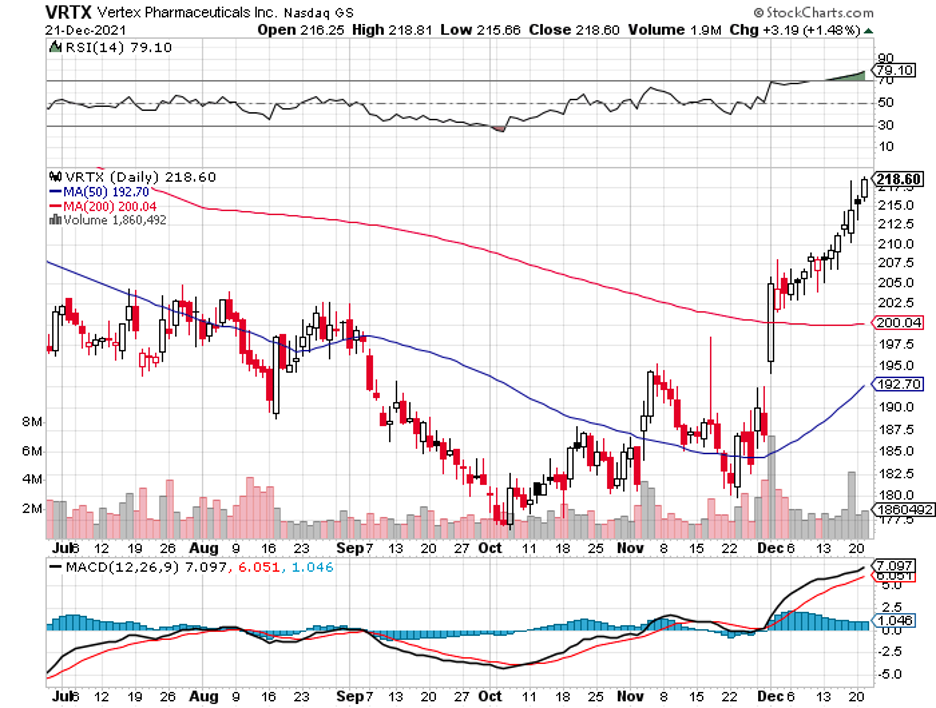It’s the season to start some holiday shopping, and you don’t have to limit yourself to gifts for friends and family.
You might want to expand your shopping list to include a few bargain stocks as well.
These names typically have solid fundamentals but have seen their share prices tumble for one reason or another.
One of them is Vertex Pharmaceuticals (VRTX).
Vertex has one of the most exciting growth stories in the biotechnology and healthcare industry.
Sadly, the stock has fallen in the past 12 months despite the continuous rise of the company’s business.
The primary cause was the failure of two of Vertex’s candidates, VX-814 and VX-864. These two drugs were supposed to target rare genetic lung and liver conditions.
More importantly, both were slated as the next growth drivers for the company.
Nevertheless, it looks like Vertex has a number of candidates in its pipeline that can deliver the same if not higher growth in the coming years.
For instance, its Trikafta line appears to be continuously expanding, with its recent approval for patients aged 6 to 11 boosting the company’s quarterly revenue by 29% year-on-year to rake in $1.98 billion—or 6% over consensus.
Turning to Vertex’s core business, it remains a virtual monopoly in the cystic fibrosis treatment sector.
Looking at the market, the company has identified roughly 30,000 more patients with CF who are eligible to seek treatment with Vertex’s drugs.
In terms of sales, that translates to an additional $5.4 billion—or 37% of the current revenues.
It’s even safe to say that Vertex can easily corner this remaining market since Trikafta’s patent protection is valid until 2037.
Aside from that, the closest challenger in this market is AbbVie (ABBV), which has an experimental drug in Phase 2 trials.
If all goes well for the latter, then the results for that stage would be out by the first quarter of 2022.
Even assuming that AbbVie’s candidate succeeds in Phase 2, there’s still the third stage of research, which would take at least a few more years before the drug enters the market.
Meanwhile, Vertex has also been amping up its CF pipeline with new experimental CF drugs based on a combination of its already successful products.
Based on preliminary data, these new candidates may turn out to have even higher efficiency than Trikafta.
Speaking of monopoly, Vertex hasn’t forgotten the 10% of CF patients who aren’t eligible for its current therapies.
To completely corner the market, Vertex has partnered with leading gene therapy experts to develop two new drugs for the remaining 10%—and these “experts” are renowned heavyweights in the biotech sector as well: CRISPR Therapeutics (CRSP) and Moderna (MRNA).
Outside its core business, Vertex has been expanding its pipeline to cover other markets.
One of its exciting candidates is CTX001. This is a gene therapy that’s supposed to be a one-time cure for rare conditions B-thalassemia and sickle cell disease. The company plans to apply for regulatory approval by the end of 2022.
If this works out, then Vertex is looking at an addressable market size of 32,000, which translates to $2 billion in annual sales.
Another promising candidate is VX-548, which is an acute pain treatment. While 90% of the prescribed drugs for this condition are generic, this still amounts to a $4 billion market in the United States alone.
Moreover, the average cost for a branded acute pain medicine is roughly $10 daily. That means any highly effective drug has the potential to generate several billion dollars in sales.
Regardless of how some of its candidates turned out, Vertex remains a company with a healthy and promising growth profile.
Hence, it’s not much of a stretch to argue that its current stock valuation looks attractive, especially for long-term investors.

